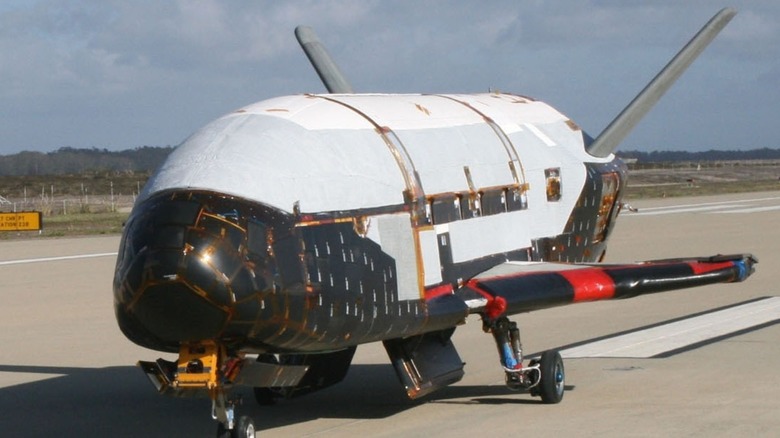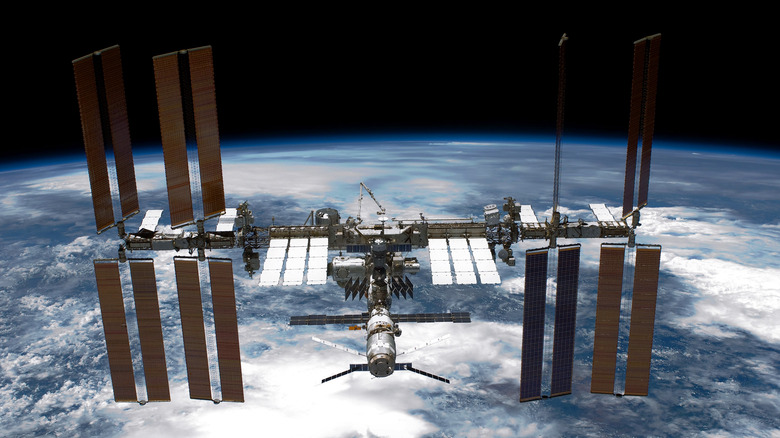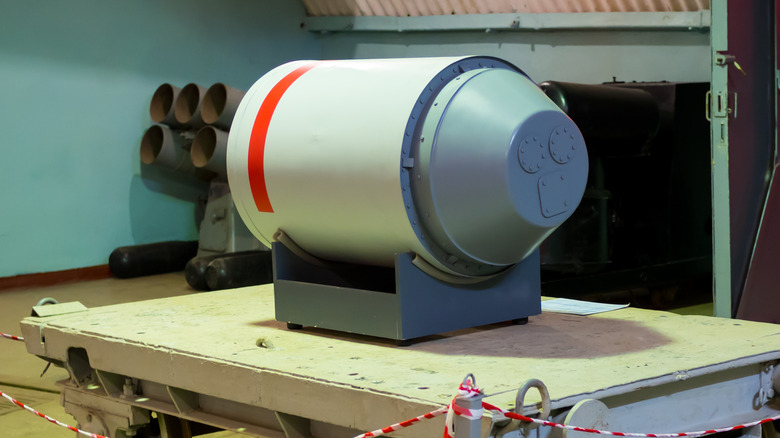Here's What We Know About The Air Force's Secret Space Plane
The mission for the unmanned and mysterious U.S. Air Force space plane, X-37B, is to serve as a demonstrative test run for reliable and reusable materials and technologies for spacecraft in orbit. Its primary objective is to utilize reusable components to operate experiments in space and return to Earth to be examined.
The experimental test vehicle was constructed by Boeing. It stretches over 29'3" in length and sits nearly 10 feet off the ground. Its wingspan reaches nearly 15 feet and it weighs 11,000 pounds. It is powered by Gallium Arsenide Solar Cells, via lithium-ion batteries, and utilizes the launch vehicles, SpaceX Falcon 9 and United Launch Alliance Atlas V (501) (via U.S. Air Force).
The X-37B, which launches vertically and lands horizontally, made its way back out into space in May of 2020, on a classified mission, during which it also deployed a small orbital satellite, FalconSat-8. The spacecraft also ran tests on what happens to seeds and food items when exposed to radiation in space.
"We've learned a lot from the X-37B," said Gen. John Raymond, Chief of Space Operations, to Defense News. "One of the things that we've learned is the value of reusability, and I think, as a Space Force, there's a couple of things that we're really going to value, and reusability is one of those, and autonomy is another one."
What X-37B is up to at the moment
The current mission called for numerous experiments involving perishables in space, but also a few initiatives which are unknown to the public. In fact, when X-37B entered the outer atmosphere and discharged its separation rocket, the live stream cut off, because of the extremely confidential measure of the mission.
"It's a classified mission, and what is classified about it is the details of the vehicle itself, the mission it will do in orbit and where it will do that," said United Launch Alliance CEO Tory Bruno. "Therefore we had to stop the live broadcast so that we didn't make it easy for adversaries to figure those things out by having that much data about the flight and deployment."
X-37B is also currently testing a solar power system which sends a laser to Earth, while also porting smaller satellites as well (via Popular Mechanics). However, it still remains a mystery as to the purpose of its deployed satellite, FalconSat-8.
What's the history of the X-37B spacecraft?
The X-37B has successfully navigated five missions as part of the Air Force contract, OTV-1 through OTV-5. Each of them has launched from Cape Canaveral, Florida, with the first coming in April of 2010, while spending nearly 2,900 days in orbit. The current mission, which blasted off in May of 2020, is OTV-6, is again testing reusable technology for experiments.
The X-37 program was conceived in 1999 by NASA with the initial plan of manufacturing two different vehicles: one is orbital, and the second is an Approach and Landing Test Vehicle (ALTV). The contract was transferred to the U.S. Defense Advanced Research Projects Agency (DARPA) in 2004 and, at that point, was converted to classified. The program, as it stands today, is currently assigned to the Air Force's Rapid Capabilities Office, per the 3rd Space Experimentation Squadron, at Schriever Air Force Base in Colorado (via Space).
A Russian defense contractor, Yan Novikov, recently claimed that the X-37B can port nuclear weapons and believes that the U.S. is gearing up to do just that: drop bombs from orbit. He goes on to say that the Air Force has two planes, which can carry up to six nuclear warheads, and the true nature of them is to build a nuclear armada with eight such aircraft by 2025. These claims, however, are completely false, according to U.S. officials (via Popular Mechanics).
Why X-37B is not a space nuclear warhead carrier
The current sole purpose of the X-37B is to execute classified U.S. Air Force missions, while spending months in space, but the best way to think about it is that the space plane is like a truck, with cargoes of many different other machines and experiments in the truck's bed. (The vehicle's cargo bay is in fact about the size of a pickup bed.)
It is actually possible to allow for the cargo bay to serve as a stash for nuclear torpedoes, because at least one thermonuclear warhead measures 12x31 inches. (Explosive yield: five kilotons.) That scenario is highly unlikely, however, because of all the modifications that would be needed for both the bombs and the spacecraft. The warheads would have to be structured with a guidance system for reentry and a deorbiting technology to allow for making its way down toward a target, all just to land perfectly, which coming from space, would be incredibly difficult.
Ultimately, Novikov's claims are nothing more than speculation. The U.S., as it currently stands, does not possess the ability to launch a nuclear-armed space armada attack on Russia (or anywhere else on the globe, for that matter) (via Popular Mechanics).



